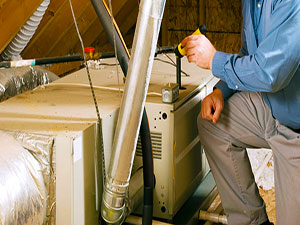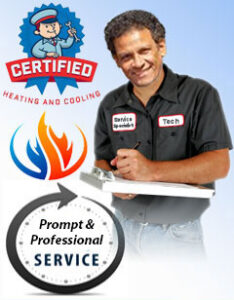 For your furnace repair, below is a thorough list of how to fix your gas furnace yourself or troubleshoot what needs to be fixed before calling a pro. We’ve organized a complete checklist with all the problems & causes.
For your furnace repair, below is a thorough list of how to fix your gas furnace yourself or troubleshoot what needs to be fixed before calling a pro. We’ve organized a complete checklist with all the problems & causes.
These furnace repair tips apply to both conventional or high efficiency gas furnaces, fired by either natural gas or propane & with either a pilot light (most older systems) or electronic ignition (most newer systems). This info is not for electric furnaces or heat pumps which are different types of heating systems.
To prevent heating issues that could be more costly it’s best to have a system inspected every year or so. Before attempting any furnace repairs which could void a warranty, call a professional. With inexperienced do-it-yourself repairs there is some risk of creating more problems if you’re not careful. If you take your time & follow instructions though, you could very well learn something, save alot of money & get the satisfaction of doing the furnace repair yourself.
Knowing how to use any $25 multimeter will enable you to do more extensive troubleshooting by being able to test several parts for power to see if the part itself needs replacement, such as the thermostat, breaker, blower motor, limit switch, fuse, shut off switches, flame sensor & igniter.
In case you smell gas, vacate the property immediately, leave the door open, turn off the gas supply by the meter and call your utility company.
We’ve placed here a complete checklist so you can quickly see each problem followed by the list of causes. The easier items to check are at the top of each list. Below this checklist are details about fixing each problem. Click on any of the problems or causes in this list to jump to the below section about how to fix each furnace repair problem.
Furnace Repair Problems & Causes:
Furnace doesn’t heat at all
• thermostat not set to heat
• thermostat has low or dead battery, or battery contacts are dirty or corroded
• thermostat wiring, faulty dirty or corroded
• thermostat improperly programmed
• thermostat has malfunctioned & needs replacement
• thermostat not properly located to get accurate reading
• gas line valve is shut off
• breaker panel switch for furnace has tripped to off
• furnace has a burned out fuse
• furnace has a shut off switch that’s switched off
• furnace door has a safety switch that needs to be reset or needs replacement
• blower motor has a safety switch that needs to be reset
• blower motor failure
• condensation drain line is clogged (high efficiency furnaces)
• pilot light not lit due to clogged orifice
• pilot light not lit due to faulty igniter (electric ignition)
• pilot light not lit due to flame level adjustment screw set too low
• pilot light not lit due to draft blowing out pilot light
• flame sensor needs cleaning (electric ignition)
Furnace doesn’t heat enough
• furnace is too small for space
• thermostat battery, contacts, wiring, placement or faulty thermostat
• clogged filter
• vents are closed or obstructed
• clutter around furnace or air flow around furnace is restricted
• faulty igniter not keeping the pilot burning (electric ignition)
• blower motor needs oil
• burners clogged & need cleaning
• flame sensor needs cleaning
Furnace doesn’t heat at all & blower runs continuously
• limit switch needs replacement or adjustment
Furnace heats but blower runs continuously
• thermostat fan switch set to run continuously
Furnace frequently turning on & off
• clogged filter
• dirty blower wheel
• closed air vents
• faulty thermostat
• flame sensor needs cleaning
Furnace runs but doesn’t blow air out from vents or blows weak
• broken or loose blower belt
• blower motor failure
• dirty blower wheel
Furnace or duct work noisy
• squealing: loose or broken blower belt
• rattling: loose screws on panels
• squeaking: draft inducer motor wearing out or set screw on blower fan wheel needs tightening
• grinding: worn bearings
• pinging: normal sound caused by ductwork expanding & contracting from heating or cooling
Fix-It-Yourself Furnace Repair Tips
Furnace doesn’t heat at all
• Thermostat not set to heat: Make sure the thermostat is set to heat. See if increasing the temperature a few degrees turns on heat within a few minutes.
• Thermostat has low or dead battery: Check the display if it’s dim, off or if the time/date are incorrect, indicating a low battery (some thermostats are wired to electrical so this wouldn’t apply). If so, open the thermostat to replace the battery & also check the the battery contacts which could be dirty or corroded & need cleaning. Clean with a cotton swab & alcohol.
• Thermostat wiring, faulty dirty or corroded: Open the thermostat to see if there’s any obvious dirt or corrosion to the wiring. See the below video to test the wiring.
• Thermostat improperly programmed: Try overriding the thermostat programming by setting temperature & pressing hold button to see if furnace turns on. Check the manual for programming instructions.
• Thermostat has malfunctioned & needs replacement:
See the video below to test your thermostat. Thermostats can eventually fail & need replacement, it’s not too difficult to do yourself.
• Thermostat not properly located to get accurate reading:
An improperly located thermostat, such as in direct sunlight, will give inaccurate readings & not turn the system on & off when needed. You may need a pro to relocate it.
• Gas line valve is shut off:
Make sure it’s on, it should be in line with the gas pipe (not in perpendicular position). You know it’s on if the hot water tank is working.
• Breaker panel switch for furnace has tripped to off:
Check the house circuit breaker panel, see if the switch for the furnace is on. If it’s off turn it all the way to off then to on. Do it a few times to make sure it stays in on position, then wait 5 minutes & see if the heat comes on, if not check the fuse. A tripped breaker could be a one time occurance but if it keeps happening you will need an electrician. There is some circuit breaker testing you can do with a multimeter to see if the breaker itself has gone bad (see this video).
• Furnace has a burned out fuse:
If breaker switch is already on then turn it off & check if there’s a fuse for the furnace which is burned out & needs replacement.
• Furnace has a shut off switch that’s switched off:
Some furnaces have a power switch on or nearby the furnace, it could be a wall switch just like a light switch.
• Furnace door has a safety switch that needs to be reset or needs replacement:
Some furnaces have a safety switch on the furnace door which will prevent the fan & burner from running if off. In rare instance on an old unit it’s possible the switch has malfunctioned & needs replacement. You would need to check the connection with a multimeter to confirm it’s working.
• Blower motor has a safety switch that needs to be reset:
Some blower motors have a safety switch which needs to be reset, if so press it, if the system doesn’t turn on try again after 30 minutes, the motor may need to cool.
• Blower motor failure:
Possibly the blower motor could fail & need replacement. It would need to be tested with a multimeter to see if power is reaching the motor. If power is there but the motor isn’t running & you’ve already checked for a safety switch, then the motor will need replacement.
• Condensation drain line is clogged:
High efficiency furnaces use a condensation drain line, if it becomes clogged it will cause the furnace to shut off, the line will need to be flushed & cleared with a mix of water & 25% bleach.
• Pilot light not lit:
A Pilot may not stay lit due to being clogged, being set too low, or even due to a draft. Furnaces with electric ignition could have a faulty igniter or a flame sensor needing cleaning (see videos below). Try the following to relight the pilot, if it doesn’t stay lit after a couple tries it could need a thermocouple replacement in which case best to call a pro.
To relight the pilot: Turn off the gas valve, wait several minutes to clear gas, turn valve to pilot, push & hold down pilot button, light pilot with extension lighter, continue holding button for a minute then slowly release. Turn gas valve back on. It may not stay lit or the flame may burn yellow if the flame adjustment screw is set too low, try adjusting it until the flame stays lit and burns blue. The pilot orifice could also be clogged & need clearing. Turn off the gas & circuit breaker switch for the furnace, then poke a wire in the hole where the flame comes out to clear it.
To test the igniter with a multimeter (electric ignition)
To clean the flame sensor (electric ignition)
Furnace doesn’t heat enough
• Furnace is too small for space: If, to your knowledge, the furnace has never adequately heated there is the possibility that the furnace is not adequately sized for the space. There is a large range of furnace sizes based on BTU’s & how many square feet a furnace can heat. You just may need a more powerful system. Click here to check the required size you need.
• Thermostat: A thermostat issue could cause a furnace to not heat at all, not heat enough, or to turn on & off frequently. The problem could be the battery, battery contacts, wiring, a faulty thermostat or improper placement. If the thermostat is not situated centrally & away from direct sunlight it could give an inaccurate reading & not be turning the system on when needed. You may need a pro to relocate the thermostat. See the thermostat section covered above for more details on diagnosing the thermostat.
• Clogged filter: The easiest & cheapest furnace repair you can do yourself is to change a dirty filter, but it should be done regularly before it gets too dirty & causes other problems. Filters need replacement every 1-3 months. A dirty filter restricts air flow, reduces efficiency by causing the air handler to run more & increase electric usage. It can damage the limit switch & can overheat the heat exchanger causing it to shut off too soon. Taxing the system by not changing filters regularly can also lead to cracked heat exchangers or exhaust pipes which can leak poisonous carbon monoxide into the home. Carbon monoxide detectors should be installed near bedrooms & their batteries checked regularly. If a leak is ever detected shut off the furnace immediately & call a pro.
• Vents are closed or obstructed: Check that room vents are open & unobstructed, allowing air to freely circulate.
• Clutter around furnace or air flow around furnace is restricted: the furnace needs enough free room around it for air circulation. If the furnace is in a closet there needs to be enough air flow space under the door. Also if furnace vents are outside make sure to clear leaves & debris from the intake or exhaust.
• Faulty igniter not keeping the pilot burning (electric ignition) See the video above on how to test the igniter.
• Blower motor needs oil: Most newer motors don’t need oil, but older motors may require oil & will have an oil port & may have a cover plate. Lubricate once a year with 2 to 3 drops of detergent free motor oil.
• Burners clogged & need cleaning: Check if flames are blue & even, if yellow or flickering the burners may need cleaning. It should be cleaned annually with a vacuum after turning off gas & power.
• Flame sensor needs cleaning: Click & see this video on how to clean the flame sensor.
Furnace heats but blower runs continuously
• Thermostat switch: It’s probably set to run the fan continuously (may bet set to ‘on’ ‘low’, ‘medium’ or ‘high’). Set it to ‘auto’ so that it only runs when the heat is on.
Furnace doesn’t heat at all & blower runs continuously
• The limit switch likely needs replacement or adjustment. When it goes bad the flame will go off but the blower continues running. Check the owners manual for instructions on adjusting limit switch or call a pro for your furnace repair.
Furnace frequently turning on & off
• Clogged filter: the most common cause of the furnace turning on & off frequently is a clogged filter, which can cause a number of problems. Change filters regularly every 1-3 months. It’s the easiest & most cost effective furnace repair you can do yourself.
• Dirty blower wheel: lack of regular filter replacement could result in excess dirt buildup on the blower wheel, which will cause it to turn less freely & reduce the system efficiency, using more electricity, eventually requiring expensive repairs. Turn the system off, clean the wheel & replace filters regularly.
• Closed air vents: Closed vents can limit air to the heat exchanger causing the system to turn on & off frequently. Best to keep all vents open even in unoccupied rooms.
• Thermostat: A thermostat issue could cause a furnace to not heat at all, not heat enough, or to turn on & off frequently. The problem could be the battery, battery contacts, wiring, a faulty thermostat or improper placement. If the thermostat is not situated centrally & away from direct sunlight it could give an inaccurate reading & not be turning the system on when needed. You may need a pro to relocate the thermostat. Click to jump to the thermostat section covered above for more details on diagnosing the thermostat.
• Flame sensor needs cleaning: If the sensor is dirty it won’t detect the flame & will keep the gas shut off & the system won’t run. Click & see video how to clean flame sensor.
Furnace runs but doesn’t blow air out from vents, or blows weak
• Broken or loose blower belt: Check if the belt is not broken or needs tightening. Turn off gas & power, remove access panel, check belt number & get a replacement if needed. Put one end of belt on the small pulley first then rotate the other pulley while slipping the belt on that end. You may need to adjust belt tension so that it moves no more than an inch when pressing on it.
• Blower motor failure: The furnace will usually not run if the motor has failed, though it is possible. It could also run only at partial speed if it’s failing, causing the air to blow weak. First check the motor for a safety switch. Then test it with a multimeter for power, it will need replacement if it’s getting power & not running.
• Dirty blower wheel: A dirty blower wheel caused by infrequent filter changing will reduce air flow, increase electricity use & cause other problems. Clean the wheel & change filters regularly.
Furnace or duct work noisy
• Squealing: Loose or broken blower fan belt – adjust the motor mount to tighten the belt (should only have one inch of play when you down press on it), or replace belt if broken.
• Rattling: Tighten loose screws on panels.
• Squeaking: This can be caused by the draft inducer motor wearing out or it may be the set screw on the blower fan wheel needs tightening, if it’s loose the wheel can wobble & squeek. Tighten the screw or replace the blower wheel.
• Grinding: Can be caused by worn bearings in which case you should shut off the system & call a tech.
• Pinging: Metal heating ducts can carry noise as a normal result of thermal expansion & contraction as the ductwork heats & cools. To reduce noise flexible insulated ductwork can be placed between the hvac system & ductwork.
Good luck with your furnace repair. If you need a professional hvac technician in Brooklyn, NY call us at 718-690-3718








